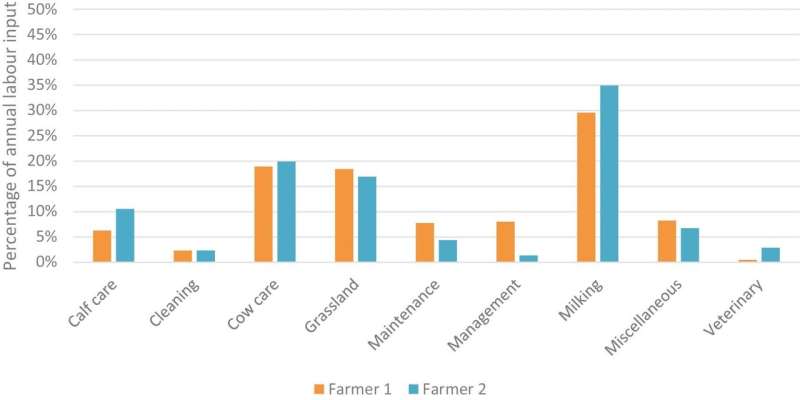This article has been reviewed according to Science X's editorial process and policies. Editors have highlighted the following attributes while ensuring the content's credibility:
fact-checked
proofread
Efficient practices and facilities key to reducing labor on Irish family dairy farms

A core strength of the Irish dairy industry is the role of the family in the operation of the dairy farm. However, the success of family farms is also highly dependent on conducting a labor-efficient farming operation.
New research from Teagasc Moorepark shows that overall labor requirement on a dairy farm can be significantly reduced by applying appropriate farm facilities and efficient practices. This focus is particularly important now since reduced availability of farm workers is being experienced, combined with farmers themselves placing greater emphasis on achieving a good work-life balance.
This research used a case-study approach and is published Oct. 28 in the Irish Journal of Agricultural and Food Research. The study emphasizes the importance of managing the farm facilities, work tasks and practices in an efficient manner, particularly those associated with the most time-consuming jobs of milking and calf care.
Acceptable workloads
The case-study highlighted that a 119 cow dairy herd can be managed with less than 3,000 (2,986) hours of labor input per year (or 54 hours/week). In this instance, the farmer contributed 77% of the labor input (2,314 hours/year or 47 hours/week).
Previous research obtained through questionnaires have indicated that farmers considered working less than 55 hours per week to be an acceptable working week. This level of labor efficiency was achieved while the farm met all of the key targets for a spring-calving herd. This study clearly indicates the importance of efficient facilities, work practices and technologies. Such an approach is particularly important in ensuring that the peak workload in spring is managed effectively. It also ensures that the need for additional labor input is not over-estimated by being based on inefficient facilities and practices.
Lead author on the study, Dr. Marion Beecher from Teagasc, explains, "This study shows that dairy farming systems can be sustainable in terms of workload. The consideration of the different strategies highlighted with respect to farm facilities, work practices, technologies and work organization will allow farmers to make logical decisions to address their labor challenges. Placing greater value on the sustainability of workload will be essential for future dairy farming systems."
Dr. Bernadette O'Brien, Teagasc researcher and co-author on the study adds, "The results of this study offer practical solutions to improve labor efficiency; and, once efficiency is optimized through facilities, practices, and technologies, the farmer has the option to reduce their own contribution further by hiring staff or contractors, depending on economic performance."
More information: M. Beecher et al, Labour self-sufficiency on family dairy farms in Ireland: a case study approach considering labour requirement, input and management, Irish Journal of Agricultural and Food Research (2023). DOI: 10.15212/ijafr-2023-0104
Provided by Teagasc





















